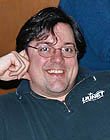 |
|
 Home Home
 Products Products
 Store Store
 Forum Forum
 Warehouse Warehouse
 Contact Us Contact Us

|
|
|
|
 
|
|
Author
|
Topic: Bytowne Cinema curtain question
|
|
|
Frank Angel
Film God

Posts: 5305
From: Brooklyn NY USA
Registered: Dec 1999
|
 posted 07-06-2010 11:32 AM
posted 07-06-2010 11:32 AM





All depends on the construction. In our big house, the scope picture goes from side proscenium wall to side proscenium wall; there is not place for the curtain material to gather. The curtain has to travel past the proscenium and is not visible for scope films. For 1.85 or 1.66 or Academy, i.e., flat formats, I let it play a about 4 feet on either side of the masking so that I am not leaving a big expanse of black masking visible, which is pretty much ugly as sin.
In the small screening room here, the screen is nearly wall-to-wall with hardly any space for a receptical for the curtain to gather, althought his would be the ideal way to do it if the room dimentions allow. The solution for this setup is to:
1) use a VERY light curtian material (we use China Silk) so its bulk is very reduced compaired to the traditional velour and we
2) use a curved track that has a severe curve right at the ends of the travel. This allow most of the curtain material to gather almost at a right angle to the screen.
I can attest to the fact that a curved track like this one with a fairly steep curve at the corners is no fun in practical terms. It puts a severe drag on the traverse mechanism with probabably I would guess double or even triple the resistance needed to open and close the curtain. We've had to up the size of the curtain motor twice to handle it (good curtain motors like ADC, unless you get them used, are NOT cheap). The lightest weight curtain material is a must for curved tracks.
China Silk is very light but even more importantly, it is also nearly acoustically transparant so when running anything but scope where the curtain material covers the left and right speaker bins, the effect is on the sound is minimal. Also the trick that we use when playing other than scope formats, upon opening the curtain, we always open it fully, then close it to the flat stop. This allows the material to gather mostly at the end of the travel past the speakers so that the portion which does cover them once it is opened again to the flat position, is much less gathered and less dense, again aiding sound transmission.
| IP: Logged
|
|
|
|
All times are Central (GMT -6:00)
|
|
Powered by Infopop Corporation
UBB.classicTM
6.3.1.2
The Film-Tech Forums are designed for various members related to the cinema industry to express their opinions, viewpoints and testimonials on various products, services and events based upon speculation, personal knowledge and factual information through use, therefore all views represented here allow no liability upon the publishers of this web site and the owners of said views assume no liability for any ill will resulting from these postings. The posts made here are for educational as well as entertainment purposes and as such anyone viewing this portion of the website must accept these views as statements of the author of that opinion
and agrees to release the authors from any and all liability.
|
|
|
|

 Home
Home
 Products
Products
 Store
Store
 Forum
Forum
 Warehouse
Warehouse
 Contact Us
Contact Us




 Printer-friendly view of this topic
Printer-friendly view of this topic










